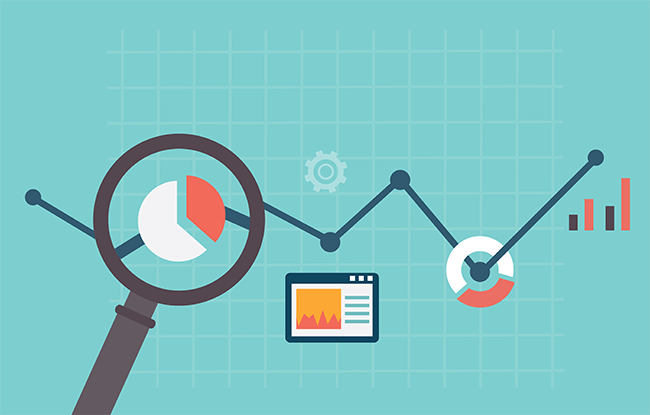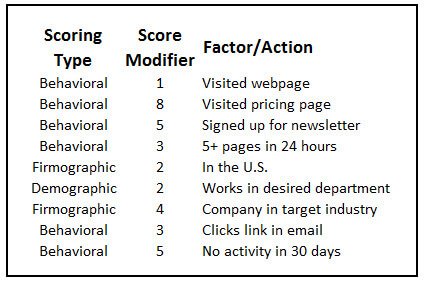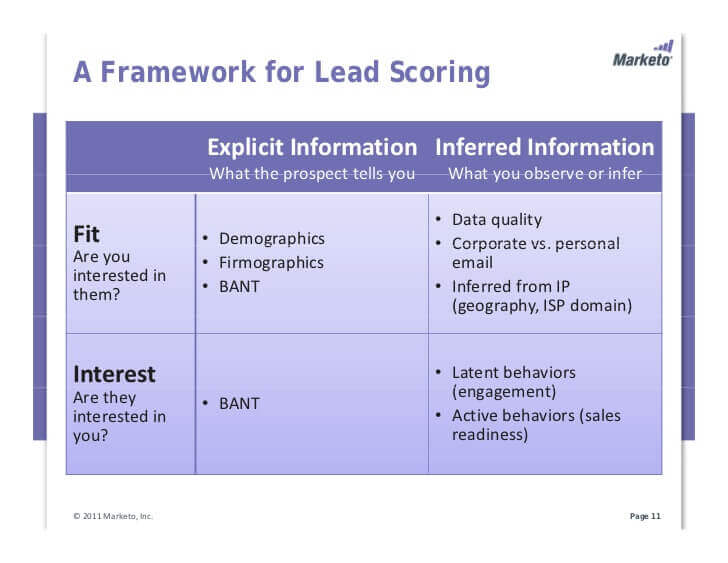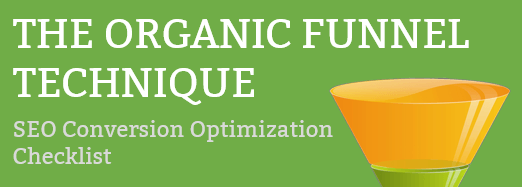
Do you currently believe that all of your website visitors hold the same value?
Unless every visitor that comes to your website or opens an email converts to a customer, then this way of thinking is wrong and could be costly for your sales team and business. As with any business, you have to know your target audience and ensure that you are reaching them by assessing the traffic you’re bringing in. One way to do this via the web is to use a marketing automation technique called lead scoring. Lead scoring shows you whether your visitors are quality or just quantity. With sophisticated lead scoring rules, the email software company Bronto Software was able to increase qualified lead conversion rates by 32 percent and improved average lead conversion time by 125%. I’ve used lead scoring with companies like Numara Software to decrease the number of leads by almost 50% yet improve the number of prospects by 30%. Like with any tool, if you use it right, it can do you a lot of good.
Why Should I Care About Lead Scoring?
The best marketing teams use lead scoring to drive quality sales.
Lead scoring is critical to any B2B company (and some B2C that are not e-commerce). Decisions about buying a product or service for a business don’t happen in just one visit to your site. Usually, they will want to watch a webinar, read a case study, get a demo or download software. You have a sales team that is hungry for leads, but they get annoyed when they get every single lead passed over to them. It also wastes their time talking to people who are not or are never going to buy.
Lead scoring is the idea of giving a prospect a score (up or down) to identify whether they are a good lead for the sales team to talk with or someone you simply need to nurture with more content till they are ready.
A great salesperson can move an engaged prospect into the sales funnel really fast. So if you can assign a number to each action that a prospect takes, once they reach a certain number that marketing and sales have agreed to, then a salesperson can reach out to them. This enables the sales team to only focus on qualified leads so that their time isn’t wasted with somebody just doing research that will string along the sales team for information without every buying.
The Two Types of Lead Scoring
There are two different types of information that you gather when scoring visitors — implicit and explicit. With explicit scoring, you are gathering details that are given to you by the prospect or otherwise directly identifiable information. Implicit scoring is information that’s observed or inferred about the prospective customer, for example, their behaviors online. By combining these two scoring systems, you are able to build a clearer picture of the value of visitors to your business and your business value.
These two types of lead scoring systems can be broken down into behaviors and demographic information. For implicit behavior, it would involve online body language, and explicit behavior involves BANT data (Budget, Authority, Need, and Timeline). Implicit demographics regard to inferred geography, data quality factors and so on. Explicit demographics relate to demographics that are taken from form data or data appending.
A Closer Look at Explicit Lead Scoring
Explicit lead scoring is based on information that is observed or directly shared and collected online through forms or registration, which can be used to compare visitors to your ideal buyer profile. BANT data is sometimes given to you from the prospect during their buying process.
With demographic and firmographic lead scoring, you are able to gather a visitor’s job title, company size, industry, and yearly revenue, depending on what information you request. Based on these details, you can determine how interested you are in a particular visitor. The closer he or she is to your buyer profile, the higher the score will be. In order to have success with this way of scoring, you must first have well-defined personas for your ideal target customer.
BANT data will allow you to determine the sales-readiness of your visitors. Here are the questions that would be answered during this assessment:
- Budget: Can the visitor afford your service or product?
- Authority: Is the visitor a decision-maker or influencer? Are they able to allocate funds?
- Need: Is your solution needed by the visitor? What is the compelling event that is driving their need? For instance, if their business performs internal processes manually and inefficiently, then the company is losing money, thus driving the need for your service or product.
- Timeline: When will the visitor make the purchase? This is tied with the compelling event: the larger the problem they face, the quicker they are likely to purchase. Or if there is a deadline, such as raising revenue/savings by end of the year, then this would be a key indicator of a timeframe for a purchase.
Keep in mind that explicit lead scoring has its limits since the information has to be shared with you by prospects. It’s recommended that you use implicit information in your visitor scoring as well.
Diving Further Into Implicit Scoring
With this method of lead scoring, the information is gathered by tracking your visitors’ behaviors, known as their online body language. This tells you their level of interest in your services or products. The data may also include inferring additional info about a visitor based on the quality of the data gathered, such as the location of their IP address, etc.
Behavioral scoring under this category provides you with information about a visitor’s readiness to make a purchase. For example, leads that open emails, visit Web sites and respond to offers are signs of high interest. A visitor that reaches your product page is showing even better-buying behavior than those that visit your careers page.
The way visitors act online-only shows you one part of a visitor’s behavior. It doesn’t tell you where the visitor is in the buying cycle. This is when you take the information and score it based on importance. For instance, a prospect who clicks on a product discount link in an email you sent should be ranked higher than someone who clicks on an industry link.
Learn to Understand Your Visitors Buying Behavior
With these lead scoring systems, you can have a better idea of who is visiting your site so that you can funnel quality leads to your sales teams and make them much happier with marketing teams. With this knowledge, you can retrofit your content and marketing strategies so that you can increase your reach to those who show the most interest in your business. And just maybe you’ll be able to increase your revenue in the process.



